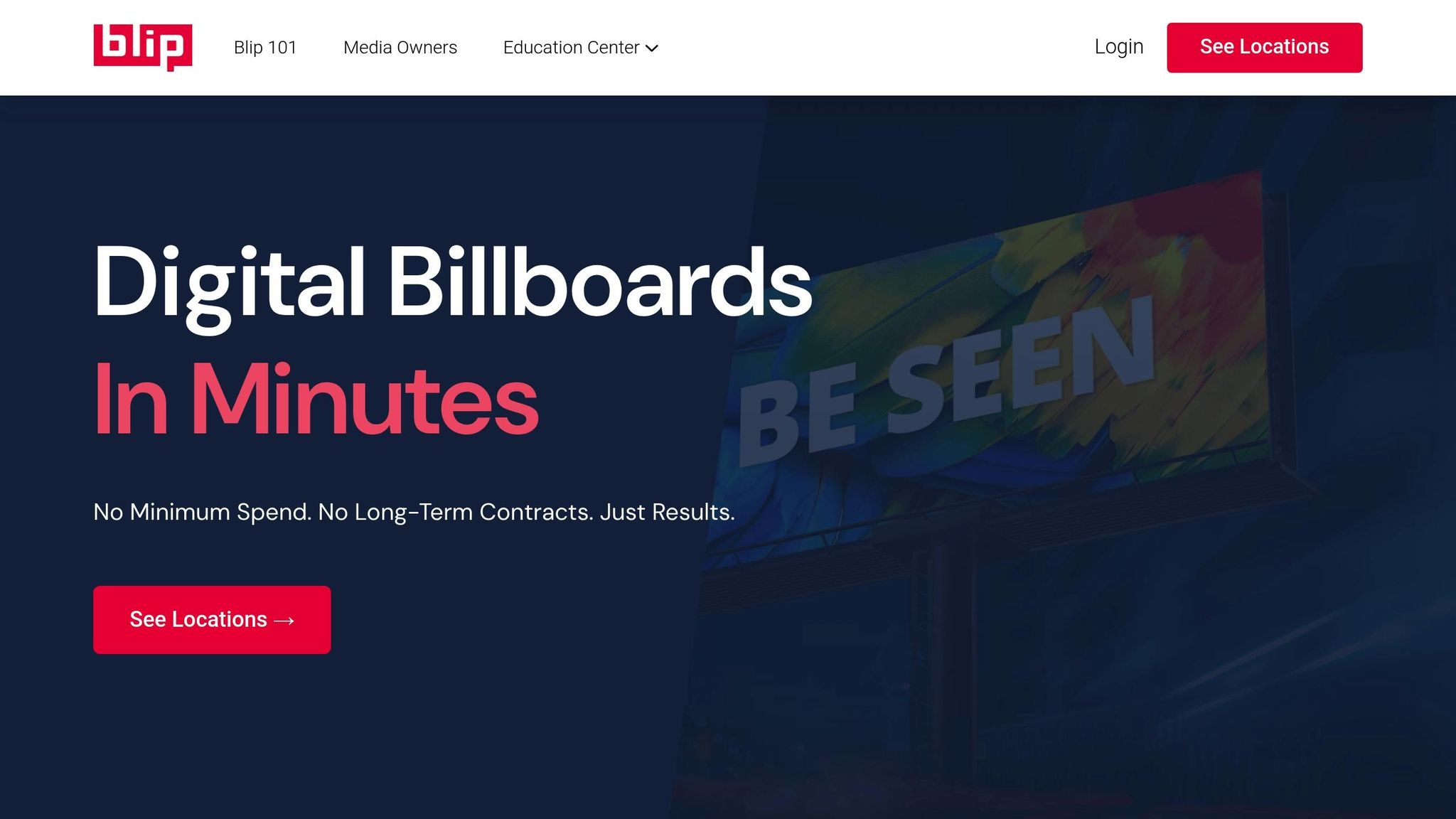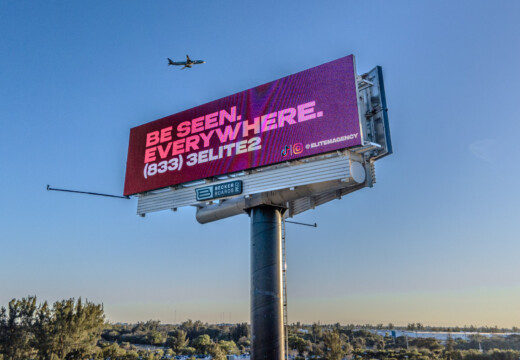Tracking ROI for multi-channel campaigns helps you spend smarter and improve results. Here’s why it matters and how to do it:
- Measure Success: See which channels (like billboards, social media, or email) work best.
- Save Money: Focus budgets on what delivers the most value.
- Understand Channel Interactions: Learn how platforms work together to boost results.
Key Steps to Start:
- Set clear goals and metrics (e.g., impressions for billboards, click-through rates for email).
- Use tools like Blip to track real-time data across all channels in one place.
- Test and adjust campaigns based on live results (e.g., optimize ad designs or schedules).
- Combine data to understand customer journeys and improve performance.
Quick Tip: Platforms like Blip make it easy to track billboard ROI with metrics like impressions, CPM, and location performance while integrating with other channels for a complete view.
Get started by defining your goals, tracking key metrics, and using data to refine your strategy.
Mastering Multi-Channel Attribution: Top 5 Tools
Set Campaign Goals and Success Metrics
Define clear, measurable goals for each channel, ensuring they align with your broader business objectives. Use real-time data to make adjustments and refine your approach.
Choose Key Metrics Per Channel
Each marketing channel requires specific performance metrics. For example, when using digital billboards, focus on impressions and cost per thousand impressions (CPM) to evaluate reach and cost efficiency.
Paul Willey, owner of Mr. Charlie’s Chicken Fingers, highlights the importance of selecting the right metrics:
"Working with Blip has given Mr. Charlie’s the momentum to get our new location on the map while accelerating growth for our original location"
Here’s a breakdown of key metrics to track across various channels:
| Channel Type | Primary Metrics | Secondary Metrics |
|---|---|---|
| Digital Billboards | Daily Impressions, CPM | Peak Viewing Times, Location Performance |
| Social Media | Engagement Rate, Reach | Shares, Comments, Saves |
| Website | Conversion Rate, Time on Site | Bounce Rate, Pages per Visit |
| Open Rate, Click-through Rate | List Growth, Unsubscribe Rate |
Plan Budgets and Set Target Goals
Allocate your budget strategically, considering both past performance and your current priorities. Kimberly Pinkson, owner of Pretty In Pinkston, explains why choosing the right channels matters:
"Blip works for us. It’s a different medium, and it brings a lot of exposure. It sets us apart from the rest of the [competition], and that’s what I like"
When defining target goals, keep these factors in mind:
- Baseline Performance: Start by documenting your current metrics for all channels.
- Industry Benchmarks: Research standard performance indicators relevant to your industry.
- Available Resources: Set goals that align with your budget and team’s capacity.
- Seasonal Variations: Account for seasonal trends that might affect performance.
These goals and budgets will serve as the foundation for analyzing and integrating data across channels.
Combine Data From All Channels
Bringing together performance data from all your channels gives you a complete picture of your campaign’s impact. Blip makes this process easier by centralizing real-time performance data for every channel in one dashboard.
Use Blip‘s Performance Dashboard

Blip’s dashboard provides real-time insights into how your billboards are performing. Here’s what you can track:
| Metric Type | What You’ll Track | Why It Matters |
|---|---|---|
| Impression Data | Daily Views, Peak Hours | Gauge how far your message is reaching |
| Cost Analysis | CPM, Total Spend | Keep your budget on track |
| Location Performance | Billboard-specific metrics | Pinpoint your best-performing spots |
| Campaign Timeline | Display frequency, Duration | Fine-tune your scheduling |
The dashboard also helps with:
- Cross-channel attribution: See how billboard exposure drives website visits or store traffic.
- Performance correlation: Understand how different channels work together.
- Budget allocation: Shift spending toward the most effective areas.
- Geographic impact: Compare performance across different locations.
By analyzing this data, you can refine your strategy and better understand how customers interact with your brand.
Track Customer Paths Between Channels
Mapping out how customers move between channels allows you to measure ROI more accurately. Ray Bowens, Founder of Hashtag-Vape, highlights the power of Blip:
"Billboards are one of the most impactful ways to advertise, and with Blip, you spend a fraction of what you would end up paying elsewhere".
Here’s how to track customer paths effectively:
- Set up tracking parameters: Use unique URLs or promo codes for each channel.
- Monitor conversion paths: Identify which channel combinations drive the most conversions.
- Analyze timing patterns: Spot peak performance periods to optimize your efforts.
- Trace engagement: Track how customers interact with multiple touchpoints.
Consistent tracking across all channels is key to making informed adjustments and improving campaign performance.
sbb-itb-2e2e93f
Improve Campaigns Using Live Data
Using live data lets you make quick adjustments to improve your campaign’s ROI. With the unified dashboard mentioned earlier, you can monitor real-time insights and make informed changes to your strategy. This continuous feedback loop helps fine-tune your campaign for better results.
Test Different Ad Designs
Blip’s platform simplifies testing multiple billboard designs at the same time. Here’s how you can make the most of your tests:
| Testing Element | What to Measure | How to Optimize |
|---|---|---|
| Message Variations | Impression rates, engagement | Try 2–3 different value propositions |
| Visual Elements | Engagement time, conversion rates | Experiment with layouts, colors, and imagery |
| Call-to-Action | Response rates, website traffic | Identify which CTAs drive the most action |
| Timing | Performance during peak hours | Adjust display schedules based on results |
To collect useful data, run your tests for at least two weeks.
Update Campaigns Based on Results
Once you’ve gathered test data, use it to refine your campaign:
-
Budget Optimization
Check daily performance and shift your budget toward top-performing locations and times. With Blip’s $20 daily minimum spend, you can experiment with budget allocations without much risk. -
Schedule Refinement
Focus on high-engagement hours. Blip’s 10-minute bidding cycles make it easy to tweak schedules based on performance data. -
Location Strategy
Use metrics like impressions and CPM to identify the best locations. Key factors to consider include:- Traffic patterns by time of day
- Conversion rates in specific areas
- Cost per thousand impressions (CPM)
- Proximity to your business or target audience
-
Cross-Channel Integration
Take successful billboard content and apply it to other marketing channels for consistent messaging.
Conclusion: Keys to Multi-Channel ROI Success
Tracking ROI across multiple channels requires a strong focus on data and the right tools. Stanford marketing professor Dr. Lisa Yang highlights this:
"Our research shows integrating digital billboards with mobile ads increases brand recall by 63%. Platforms like Blip that provide granular location and time data enable true multi-touch attribution previously impossible with static billboards."
Research demonstrates that multi-channel strategies outperform single-channel campaigns, delivering 24% higher conversion rates and 48% lower cost-per-action. These results are driven by three key factors:
| Success Factor | Key Benefit | Impact |
|---|---|---|
| Unified Data Integration | Real-time performance metrics across channels | 71% of marketers report measurable ROI improvements |
| Continuous Testing | Optimized creative and timing | 2.3x higher ROI with journey-focused tracking |
| Smart Budget Allocation | Efficient resource use based on performance | 50% of multi-channel marketers hit financial targets vs. 30% |
These elements – integrated data, ongoing testing, and thoughtful budgeting – are the foundation of ROI success.
Blip’s cross-channel attribution showcases how effective multi-channel strategies can be. For example, a Florida resort redirected $15,000 from underperforming radio ads to billboard placements near airports. This adjustment led to a 19% increase in bookings per marketing dollar. Similarly, a pizza chain used Blip’s real-time performance updates (refreshed every 10 minutes) to reallocate their daily budget, boosting total ROI by 34%.
Looking ahead, Blip plans to launch a Shopify POS integration in Q4 2025. This update will enable direct sales attribution for brick-and-mortar businesses, reducing ROI calculation errors by 57% compared to older methods. This advancement will make it even easier for businesses to track and maximize returns across all channels.
FAQs
How can I measure the ROI of my multi-channel marketing campaigns in real time?
You can measure the ROI of your multi-channel campaigns – spanning digital billboards, online ads, and more – by leveraging Blip’s analytics tools. These tools provide real-time data on impressions, costs, and performance, making it easy to see how each channel contributes to your overall results.
With Blip, you can track key metrics, optimize your budget, and make data-driven decisions to maximize your campaign’s impact. Whether you’re running ads on digital billboards or other channels, you’ll have the insights needed to evaluate your ROI effectively.
What key metrics should I track to measure ROI for campaigns across channels like digital billboards, social media, and email?
To effectively measure ROI for multi-channel campaigns, focus on metrics that align with your goals for each channel. For digital billboards, key metrics include total impressions, cost per thousand impressions (CPM), and engagement metrics like website visits or store traffic driven by the campaign. On social media, track click-through rates (CTR), engagement rates (likes, shares, comments), and conversions from ad clicks. For email campaigns, monitor open rates, CTR, and conversion rates.
By combining these metrics and leveraging tools like Blip’s analytics, you can gain a clear picture of your campaign’s performance and optimize your strategy for better results.
How can I use Blip to enhance my advertising strategy and maximize campaign results?
Blip makes it easy to enhance your advertising strategy by offering flexible tools to create and manage campaigns. Start by selecting your preferred billboard locations through the interactive marketplace, set your daily budget, and schedule your ads to fit your needs. Once you’ve uploaded your ad design, it will go through a quick approval process before going live.
To measure success, Blip provides detailed analytics that let you track your campaign’s performance across multiple channels. This data helps you fine-tune your strategy and ensure you’re getting the best return on investment. With Blip, you’re in full control of your advertising efforts, making it simple to achieve your marketing goals.
Related posts
- Digital Billboard ROI: Measuring Campaign Success
- How to Add Billboards to Multi-Channel Campaigns
- Integrate Billboard ROI with Google Analytics
- How to Track ROI for OOH and Digital Ads
You can measure the ROI of your multi-channel campaigns - spanning digital billboards, online ads, and more - by leveraging Blip's analytics tools. These tools provide real-time data on impressions, costs, and performance, making it easy to see how each channel contributes to your overall results.
\n
With Blip, you can track key metrics, optimize your budget, and make data-driven decisions to maximize your campaign's impact. Whether you're running ads on digital billboards or other channels, you'll have the insights needed to evaluate your ROI effectively.
"}},{"@type":"Question","name":"What key metrics should I track to measure ROI for campaigns across channels like digital billboards, social media, and email?","acceptedAnswer":{"@type":"Answer","text":"
To effectively measure ROI for multi-channel campaigns, focus on metrics that align with your goals for each channel. For digital billboards, key metrics include total impressions, cost per thousand impressions (CPM), and engagement metrics like website visits or store traffic driven by the campaign. On social media, track click-through rates (CTR), engagement rates (likes, shares, comments), and conversions from ad clicks. For email campaigns, monitor open rates, CTR, and conversion rates.
\n
By combining these metrics and leveraging tools like Blip’s analytics, you can gain a clear picture of your campaign’s performance and optimize your strategy for better results.
"}},{"@type":"Question","name":"How can I use Blip to enhance my advertising strategy and maximize campaign results?","acceptedAnswer":{"@type":"Answer","text":"
Blip makes it easy to enhance your advertising strategy by offering flexible tools to create and manage campaigns. Start by selecting your preferred billboard locations through the interactive marketplace, set your daily budget, and schedule your ads to fit your needs. Once you've uploaded your ad design, it will go through a quick approval process before going live.
\n
To measure success, Blip provides detailed analytics that let you track your campaign's performance across multiple channels. This data helps you fine-tune your strategy and ensure you're getting the best return on investment. With Blip, you’re in full control of your advertising efforts, making it simple to achieve your marketing goals.
"}}]}


